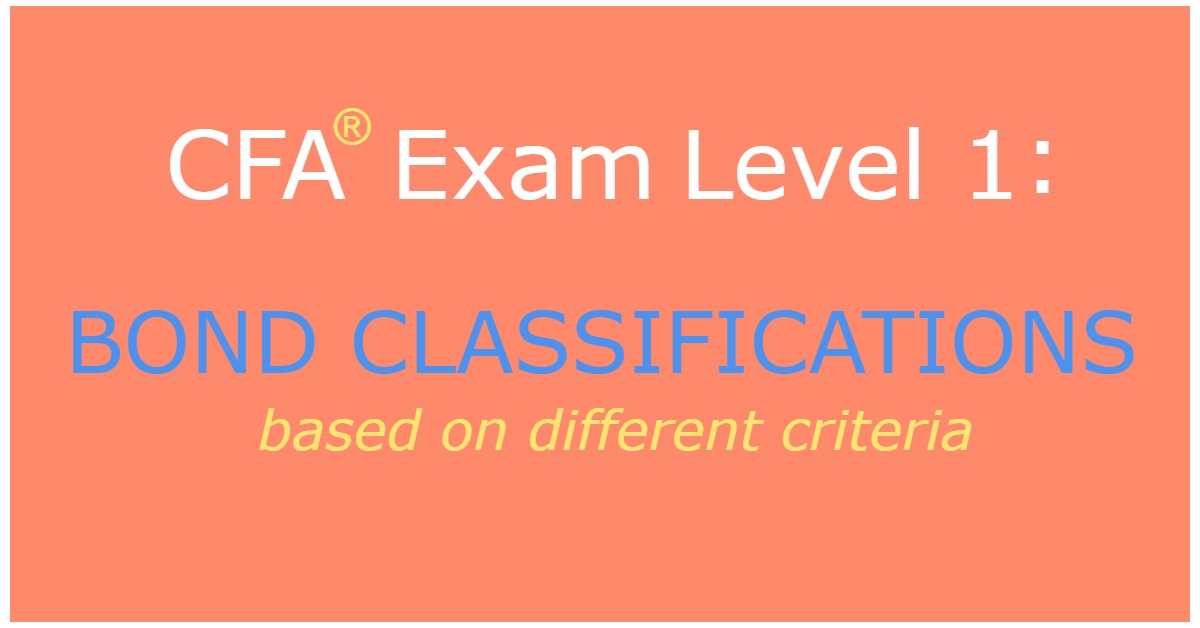Bond Types Level 1 CFA® Exam Cheat Sheet

This blog post was created as a part of the CFA exam review series to help you in your level 1 exam revision, whether done regularly or shortly before your CFA exam.
5 Criteria of Bond Classification
We can distinguish between different types of bonds depending on the criterion we choose. In your level 1 CFA exam, pay attention to these 5 criteria:
- principal repayment
- coupon payment structure
- market that the bond is traded in
- time to maturity
- types of coupon
Principal Repayment
According to the principal repayment criterion, we distinguish:
- bullet bonds, for which the par value is paid at the maturity date,
- fully amortized bonds, for which the par value is repaid in total before the maturity date,
- partially amortized bonds, for which the par value is only partially repaid before the maturity date.
Which of the following is characterized by the highest market price risk?
- A bullet bond
- A fully amortized bond
- A partially amortized bond
Answer: A
Other things held constant, the bullet bond is characterized by the highest market price risk.
It’s because the cash flows for this bond consist of a sequence of relatively small payments (coupons) and a relatively high par value paid at maturity. If interest rates increase, the decrease in the price of a bullet bond will be higher than in the case of a fully amortized bond or a partially amortized bond.
Coupon Payment Structure
According to the coupon payment structure criterion, we distinguish:
- floating rate notes, whose coupons depend on the reference rate, for example, LIBOR,
- step-up coupon bonds, which have fixed or floating coupons that increase in future periods by the specified spread,
- credit-linked coupon bonds with coupons that change when the credit rating of the issuer changes,
- payment-in-kind coupon bonds, for which there is no coupon payment made in cash (instead, at coupon dates bondholders receive new bonds or stocks issued by the company),
- deferred coupon bonds, which pay no coupon in the first year after the issuance and a couple of consecutive years but pay higher coupons in yet subsequent years,
- index-linked bonds, for which coupons and principal repayment depend on some index, for example, inflation. One of the examples of such bonds are Treasury inflation-protected securities (TIPS) issued by the U.S. Treasury.
Market That the Bond Is Traded In
Generally, the global bond market can be divided into:
- national bond markets and
- the Eurobond market.
In the national bond market, we trade with:
- domestic bonds, that is bonds issued by domestic entities in domestic currency, and
- foreign bonds, that is bonds issued by foreign entities in domestic currency. You should know that many foreign bonds are given characteristic names. For example, matador bonds are foreign bonds traded in Spain, Yankee bonds are foreign bonds traded in the US, and so on.
In the Eurobond market, Eurobonds are traded. The Eurobond market is less regulated than national bond markets and is outside of any country’s jurisdiction. An example of bonds traded in the Eurobond market are Eurodollar bonds, that is bonds denominated in US dollars, and Euroyen bonds, which are bonds denominated in Yen.
Bonds that are issued at the Eurobond market and at least one national market are called global bonds.
Time to Maturity
Generally, if we take under consideration the time to maturity, we can classify bonds as:
- short-term bonds with a term to maturity of 1 to 5 years,
- medium-term bonds with a term to maturity of over 5 to 12 years, and
- long-term bonds with a term to maturity of over 12 years.
Coupon Criterion
Taking coupons under consideration, we distinguish three basic types of bonds:
- conventional bonds, also called plain vanilla bonds, which pay fixed coupons,
- floaters, also called floating-rate notes (FRN), for which coupon changes from period to period, and
- zero-coupon bonds, also called pure discount bonds, which pay no coupons.
Which of the following is characterized by the lowest reinvestment risk?
- ...
- ...
- ...
Question 2 is available for CFA candidates using our study planner to control their prep:
Already using Soleadea? 1. Sign into your account 2. Refresh this page to see Question 2.
Level 1 CFA Exam Takeaways for Bond Types
When we choose different criteria, we can distinguish among different types of bonds:
- Principal repayment: bullet bonds, fully amortized bonds, partially amortized bonds.
- Coupon payment structure: floating rate notes, step-up coupon bonds, credit-linked coupon, payment-in-kind coupon bonds, deferred coupon bonds, index-linked bonds.
- Market that the bond is traded in: domestic bonds, foreign bonds, Eurobonds, global bonds.
- Time to maturity: long-term bonds, medium-term bonds, short-term bonds.
- Types of coupon: plain vanilla bonds, floaters, zero-coupon bonds.
LAST UPDATE: 1 Nov 2023
Read Also:

